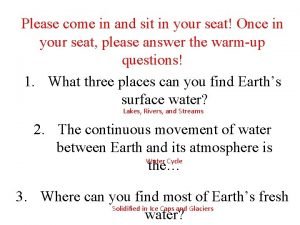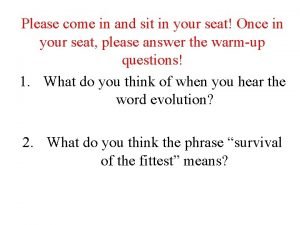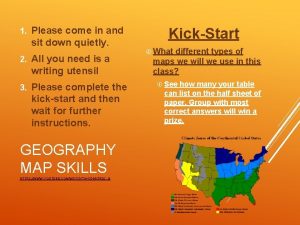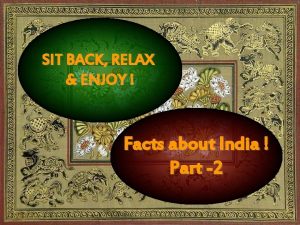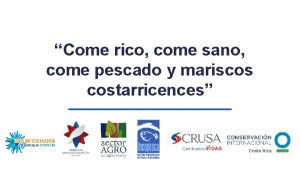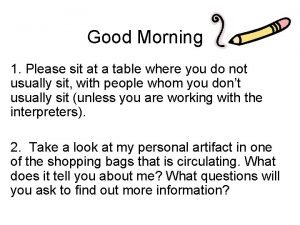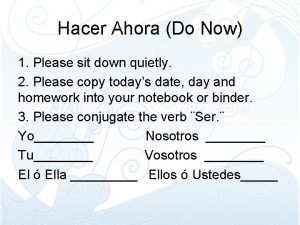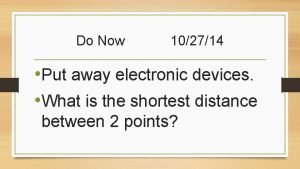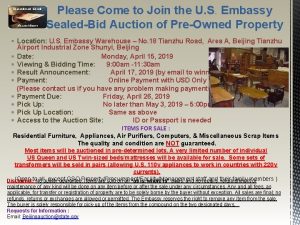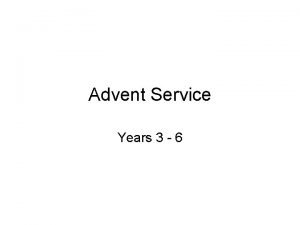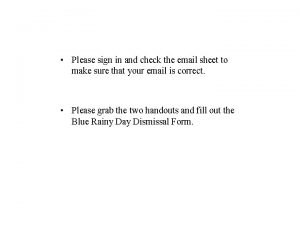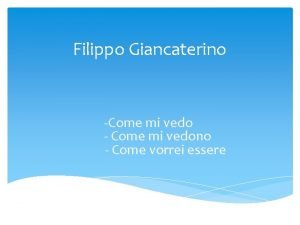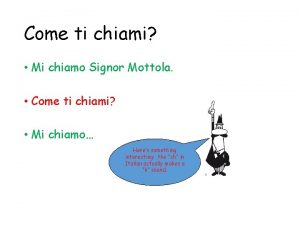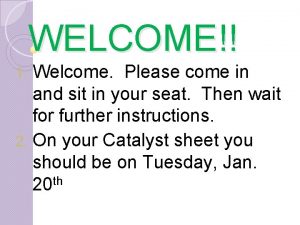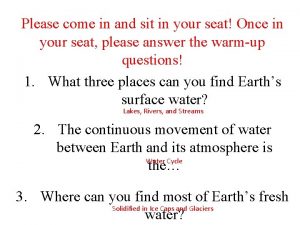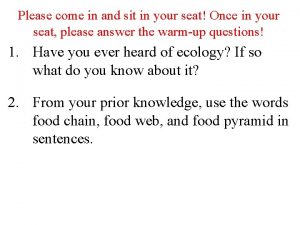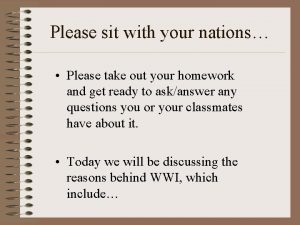WELCOME 1 Welcome Please come in and sit

































- Slides: 33

WELCOME!! 1. Welcome. Please come in and sit in your seat. Then wait for further instructions. 2. On your Catalyst sheet you should be on January 29 th

CATALYST 5 MINUTES List ten things you have done with water in your life.

CATALYST 4 MINUTES List ten things you have done with water in your life.

CATALYST 3 MINUTES List ten things you have done with water in your life.

CATALYST 2 MINUTES List ten things you have done with water in your life.

CATALYST 1 MINUTE List ten things you have done with water in your life.

TIME’S UP!!!!!

10 Things you’ve done with water in your life?

AGENDA • Catalyst • Properties of Water Notes.

ANNOUCEMENTS • Always see me for help either before or after school if you are concerned about your grade • Have bottles with you by tomorrow. If not enough, we can’t do suspension. • Yesterday’s lab.

TODAY’S OBJECTIVE • Today we will learn cohesion and adhesion work together in nature. • HS-PS 1 -3: Investigate the structure of substances at the bulk scale to infer the strength of electrical forces between atoms.

10 Things you’ve done with water? ?

Water • What is the chemical formula for water? • H 2 O • Think back to bonding, if the atoms that make up water are hydrogen and oxygen, what sort of bond is it? • Covalant?

Properties of Water • So water has a shared covalent bond. This bond is formed because of the attraction between a (+) charged Hydrogen and a (-) charged Oxygen. • So, is it possible for water to have both a hydrogen bond and covalent bond. • Yes!!!!!

Properties of Water • Cohesion holds hydrogen bonds together to create surface tension on water. Since water is attracted to other molecules, adhesive forces pull the water toward other molecules. • Responsible for the beading up of water.

Properties of Water • • Examples of Cohesion/Adhesion: 1) Shape of raindrop 2) water beading up on leaves 3) water beading up on wax • In other words, cohesion is the force of molecules of the same substance. Adhesion is the force of attraction between different substances.

Properties of Water • The cohesive forces among liquid molecules are responsible for the phenomenon of surface tension. In the bulk of the liquid, each molecule is pulled equally in every direction by neighboring liquid molecules, resulting in a net force of zero. • This elastic tendency of water which makes it acquire the least surface area possible is surface tension. (Thanks to cohesion. )

Properties of Water • https: //www. youtube. com/watch? v=Rphu. ME UY 3 Og • So how can water striders walk on water? • They can utilize the film created by surface tension AND their legs are covered with microscopic hairs that trap tiny air bubbles, allowing the insect to simply float

Exit Ticket • Complete the half sheet before leaving the classroom.

WELCOME!! 1. Welcome. Please come in and sit in your seat. Then wait for further instructions. 2. On your Catalyst sheet you should be on January 30 th

CATALYST 5 MINUTES What is the difference between cohesion and adhesion? Why can a water strider walk on water?

CATALYST 4 MINUTES What is the difference between cohesion and adhesion? Why can a water strider walk on water?

CATALYST 3 MINUTES What is the difference between cohesion and adhesion? Why can a water strider walk on water?

CATALYST 2 MINUTES What is the difference between cohesion and adhesion? Why can a water strider walk on water?

CATALYST 1 MINUTE What is the difference between cohesion and adhesion? Why can a water strider walk on water?

TIME’S UP!!!!!

Catalyst Answer • What is the difference between cohesion and adhesion? • Cohesion is the force of attraction between molecules of the same substance. • Adhesion is the force of attraction between molecules of different substances. • Why can a water strider walk on water? It takes advantage of the film on water created by surface tension and it has hairs on it legs full of air pockets.

AGENDA • Catalyst • Properties of Water Notes continued.

ANNOUCEMENTS • Always see me for help either before or after school if you are concerned about your grade

TODAY’S OBJECTIVE • Today we will learn the phases of water and learn how to tell an immiscible substance. • HS-PS 1 -3: Investigate the structure of substances at the bulk scale to infer the strength of electrical forces between atoms.

Phases of water… • What are three phases of water? • Solid, liquid, gas. • How does each phase look on the molecular level? What examples of each phase?

Miscible vs. Immiscible substances • The ability of a liquid to be mixed with another liquid is known as a miscible substance. • If the molecules in the liquids are repelled by each other and will not sizzle, then the liquids are immiscible.

Miscible or Immiscible • • Ice cubes in pop Miscible Baking soda in water Immiscible Sugar and grape kool-aid mix Miscible Oil and Water Immiscible!!!!!
 Sit on your seat
Sit on your seat Please sit down and your seat belts
Please sit down and your seat belts Come in and sit down
Come in and sit down Come in come in and sit down
Come in come in and sit down Sit ins
Sit ins Will't please you sit and look at her
Will't please you sit and look at her Hey hey people
Hey hey people Please sit back and relax
Please sit back and relax Mogans cevicheria
Mogans cevicheria Please sit at the table
Please sit at the table Will you please sit at the table
Will you please sit at the table Please sit down
Please sit down Come and sit at my table hymn
Come and sit at my table hymn Raymond carver will you please be quiet please
Raymond carver will you please be quiet please Please put away your books and come here
Please put away your books and come here Please come and join
Please come and join Please come and join
Please come and join Open up the sky fall down like rain
Open up the sky fall down like rain Louisa please come home
Louisa please come home Quoted speech to reported speech
Quoted speech to reported speech Come lord jesus come and be born in our hearts
Come lord jesus come and be born in our hearts Welcome please take a seat
Welcome please take a seat Please extend your warm welcome
Please extend your warm welcome Welcome please sign in
Welcome please sign in Come holy spirit come inflame our souls with love
Come holy spirit come inflame our souls with love He-y come on ou-t theme
He-y come on ou-t theme Come thou fount come thou king lyrics
Come thou fount come thou king lyrics Past tense of sh
Past tense of sh E m m a n u e l
E m m a n u e l Come mi chiamo come mi chiamo
Come mi chiamo come mi chiamo Softly and tenderly jesus is calling
Softly and tenderly jesus is calling Come mi vedo io e come mi vedono gli altri
Come mi vedo io e come mi vedono gli altri Turn on your radio
Turn on your radio Come mi chiamo come mi chiamo
Come mi chiamo come mi chiamo
